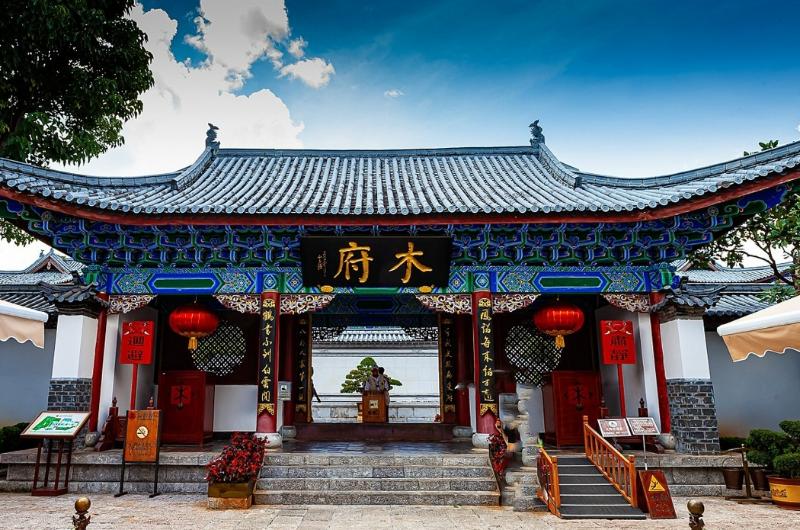Mufu

Lijiang Ancient Town: Mu Mansion
Lijiang Ancient Town, located in Lijiang City, Yunnan Province, is renowned for its unique Naxi culture and beautiful natural scenery. It is known as the "Oriental Venice". Within the ancient town, apart from the well-arranged houses, winding rivers, and ancient bridges, there is also a magnificent architectural complex, the Mu Mansion.
I. The Origin and Rise and Fall of Mu Mansion
Mu Mansion, also known as "Mu's Local Government Office," is the hereditary residence of the Naxi Mu family, and it was also the political, economic, and cultural center of the Lijiang region.
1. The Rise of the Mu Family
The rise of the Mu family can be traced back to the Yuan Dynasty. To consolidate its frontier, the Yuan Dynasty implemented the local government system, appointing minority leaders to manage local areas. The Naxi Mu family, with their exceptional military capabilities and political wisdom, gradually gained control of the Lijiang region and was eventually appointed as the "Local Government of Lijiang."
2. The Construction and Development of Mu Mansion
The exact date of the initial construction of Mu Mansion is unclear. However, historical records indicate that the Mu family had already owned a large mansion during the early Ming Dynasty. During the late Ming Dynasty, the influence of the Mu family continued to grow, and Mu Mansion underwent continuous expansion, eventually becoming a vast complex covering approximately 50,000 square meters.
3. The Decline of Mu Mansion
During the late Ming Dynasty, the Ming and Qing war broke out frequently, and the rule of the Mu family gradually declined. After the Qing Dynasty entered China, to strengthen its control over local areas, it implemented the policy of replacing local government with direct administration, abolishing the local government system, and demoting the Mu family to "Prefect." Mu Mansion also lost its political status, eventually becoming an ordinary residence.
II. The Architectural Features of Mu Mansion
The architectural style of Mu Mansion combines the grandeur of Han architecture with the intricate details of Naxi architecture, reflecting the fusion of diverse cultures.
1. Magnificent Scale and Layout
The Mu Mansion complex covers a vast area, consisting of multiple courtyards, palaces, pavilions, and towers. The architectural layout is rigorous, reflecting the Naxi people's emphasis on order and hierarchy. The main buildings within the mansion include the council hall, sleeping quarters, gardens, scripture library, and more. Each building boasts a unique architectural style and decoration.
2. Exquisite Decoration and Carving
Mu Mansion extensively uses wood carving, stone carving, and painting as decorative techniques, reflecting the Naxi people's superb craftsmanship and aesthetic taste. Mu Mansion's wood carvings are famous for their intricacy, complexity, and dynamism. The carvings often depict flowers, birds, people, and animals, imbued with a strong ethnic character.
3. Unique Building Materials
The construction of Mu Mansion primarily uses high-quality local timber, stone, bricks, and tiles, reflecting the Naxi people's full utilization of natural resources and inheritance of traditional craftsmanship.
III. The History and Culture of Mu Mansion
Mu Mansion is not only an ancient building but also a treasure trove of rich historical and cultural heritage.
1. The Governance Philosophy of the Mu Family
During their centuries-long rule over the Lijiang region, the Mu family implemented a philosophy of "ruling by virtue," emphasizing maintaining social stability, promoting economic development, and protecting cultural heritage, laying a solid foundation for the prosperity and flourishing of the Lijiang region.
2. Unique Naxi Culture
Mu Mansion is a concentrated embodiment of Naxi culture, preserving numerous valuable relics and artifacts, such as ancient Naxi musical instruments, clothing, paintings, sculptures, and more, providing valuable materials for our understanding of Naxi culture.
3. Legends and Stories of Mu Mansion
Numerous legends and stories about the Mu family circulate within Mu Mansion. These legends and stories enrich Lijiang's folk culture and add a layer of mystery to Mu Mansion, attracting countless tourists to explore.
IV. The Modern Significance of Mu Mansion
As a landmark building of Lijiang Ancient Town, Mu Mansion is not only a significant relic of Naxi culture but also a major tourist attraction.
1. Development and Utilization of Tourism Resources
Mu Mansion is one of the core attractions in Lijiang Ancient Town, attracting numerous tourists each year. The restoration and development of Mu Mansion have brought significant economic benefits to the local area and promoted the development of Lijiang's tourism industry.
2. Cultural Inheritance and Protection
Mu Mansion is an important carrier of Naxi culture. Its restoration and protection are not only to safeguard the building itself but also to protect and inherit Naxi culture. The museum, cultural exhibition center, and other facilities within Mu Mansion provide tourists with opportunities to learn about Naxi culture.
3. Local Economic Development
As a landmark building of Lijiang Ancient Town, Mu Mansion attracts countless tourists, boosting the local economy in terms of catering, accommodation, shopping, and other sectors, creating more employment opportunities for local residents.
V. Conclusion
Mu Mansion, a building imbued with historical and cultural significance, has witnessed the rise and fall of the Lijiang region and showcases the unique charm of Naxi culture. Today, Mu Mansion, as an important tourist attraction, attracts visitors from around the world to explore its secrets. It is not only a significant landmark of Lijiang Ancient Town but also a valuable heritage of the brilliant Chinese civilization.